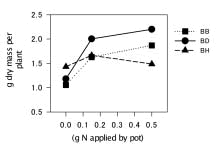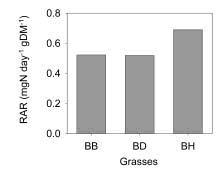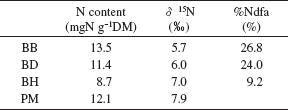Characterization of nitrogen utilization by tropical grasses (Brachiaria species) in the Brazilian savannas
Description
[Objectives]
Since the 1970's, Brachiaria species have been introduced to 40 million hectares, or 85 percent, of grassland area in the Brazilian Cerrados. The three most common species cultivated in the region are Brachiaria decumbens (BD), Brachiaria brizantha (BB), and Brachiaria humidicola (BH). Poor nutrient status of the soil, especially related to nitrogen (N), is a main factor limiting grass productivity in low fertility and acid soil areas in Brazilian Cerrados. However, interspecific differences regarding nutrient uptake and efficiency of use are not still clear in these grasses. In this study, researchers thoroughly analyzed how the grasses responded to different N supplies with a particular emphasis on how they differed in terms of nutrient uptake and efficiency of use.
[Results]
During that analysis, the N utilization characteristics of BB, BD, and BH, grown under different N conditions, were compared, as well as the grass absorption and utilization mechanisms. BB, BD, and BH were grown under different levels of N (0, 50, and 150 kg N/ha) in a pot experiment. The dry matter weight of BH was higher than those of BD and BB when no N was applied (Fig. 1). In BD and BB, dry matter weight increased when applied N levels were increased, and after sufficient N conditions, surpassed the dry matter weight of BH. The dry matter weight of BH did not increase with N application, suggesting that BH is better adapted to limited N conditions than the other two grasses. The relative N absorption rate (RAR) was of BH was higher than those of the other two grasses in the treatment without N application (Fig. 2). The smaller reduction of BH's dry matter weight under low-N conditions could be due to a high-N absorption rate.
In a field experiment, researchers estimated the contribution ratio of fixed N derived from air in the plants (%Ndfa) under no N application using the 15N natural abundance technique. Panicum maximum (PM) was considered to be suitable as a reference crop for the estimation because δ 15N of PM was highest among the four plants (Table 1). The %Ndfa of BH was lower than those of BD and BB. This indicated that the contribution ratio of soil N would be higher in BH than in BD and BB.
To evaluate root nitrate uptake capacity, a kinetic experiment was conducted. Nitrate uptake rate can be expressed according to Michaelis-Menten kinetics (Equation 1). The kinetic parameters for nitrate uptake were calculated using the depletion-method (Table 2). Km in BH was lower than BB and BD, suggesting that BH has a high affinity to nitrate and can maintain a high nitrate uptake rate under limited N conditions. BH can maintain dry matter production under limited N conditions because its roots have a high nitrogen uptake ability. BD and BB, on the other hand, can achieve high productivity under N-sufficient conditions because of their high response to applied N.
Figure, table
-
Fig. 1. Dry mass in plants under different levels of N. -
Fig. 2. Relative N absorption rates in plants with no N application. -
Table 1. Contribution ratio of fixed N derived from air in plants. (%Ndfa)
-
Table 2. Kinetic constants of NO3- uptake in B. brizantha (BB), B. decumbens (BD), and B. humidicola (BH).
-
<Equation 1>
v is the uptake rate of nitrate,
Vmax is the maximum nitrate uptake rate,
Km represents the Michaelis constant
C is the concentration of nitrate in the solution.
- Affiliation
-
Japan International Research Center for Agricultural Sciences Crop Production and Environment Division
- Classification
-
Technical A
- Term of research
-
FY2002 (FY2000-2002)
- Responsible researcher
-
NAKAMURA Takuji ( Crop Production and Environment Division )
KANNO Tsutomu ( Tohoku Agricultural Research Center, NARO )
OHWAKI Yoshinari ( NARO Agricultural Research Center )
MIRANDA Cesar. H. B. ( Brazilian Agricultural Research Corporation )
- ほか
- Publication, etc.
-
Nakamura, T., Kanno, T., Ohwaki, Y., Miranda, C. H. B. and Macedo, M. C. M. (2002): Nitrogen utilization of tropical grasses (Brachiaria species) grown in Brazilian savannas (Cerrados). Japanese Journal of Soil Science and Plant Nutrition, 73, 421-425.
Nakamura, T., Adu-Gyamfi, J. J., Yamamoto, A., Ishikawa, S., Nakano, H. and Ito, O. (2002): Varietal differences in root growth as related to nitrogen uptake by sorghum plants in low-nitrogen environment. Plant and Soil, 245, 17-24.
Nakamura, T., Miranda, C. H. B., Kanno, T., Ohwaki, Y., Pitaluga, G. M., Borges, M. J. and Macedo M. C. M. (2002): Different nitrogen uptake kinetics of ammonium and nitrate in Brachiaria spp. PDF file: R670.pdf, CD-ROM of XXV Reuniao Brasileira de Fertilidade do Solo e Nutricao de Plantas.
- Japanese PDF
-
2002_10_A3_ja.pdf944.42 KB
- English PDF
-
2002_10_A4_en.pdf63.31 KB




